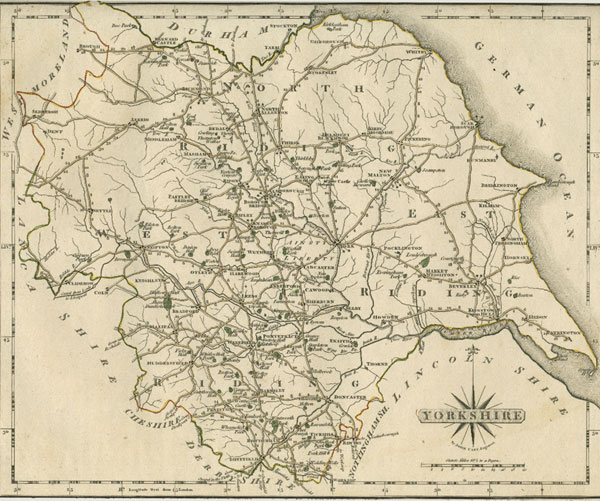Kearsley's Traveller's Entertaining Guide Through Great Britain (1803):
York. An archbishops seat, on the river Ouse at the point where the three ridings meet. It is governed by a corporation and its chief magistrate has, like that of London, the style of Lord Mayor. It is so ancient that the time of its foundation cannot be ascertained. It is certain that the emperor Severus kept his court and died here and that from hence his ashes were carried in a gold urn to Rome. Here Constantine the Great received the last breath of his father Constantius Chlorus. It was a Roman colony through which passed three military ways; and it was a garrison of the fifth and ninth legions . When it was first erected into a metropolitan see it had twelve bishoprics subject to it and all Scotland; but now it has only four; Durham , Carlisle , Chester and the Isle of Man. It suffered much in the ravages of the Danes; but under the Normans it revived. In the time of King Stephen its cathedral with several religious houses, was burnt down by an accidental fire and was not begun to be rebuilt till 1227 and was finished in 1426 being two hundred years in completing; and such care was taken in the erection of it that it seems ,that it seems to be one entire edifice, though composed of five different styles of architecture. The choir is remarkable for its fine carving. The east window was glazed in 1405 and is exquisitely painted. A library was given to this church in the last century by the widow of archbishop Matthews. In the reign of Richard I here was a horrid massacre of the Jews. Henry III had two interviews here with Alexander II, king of Scotland. A treaty of peace was afterwards concluded between them; and his son Alexander III was here married to king Henry's daughter, lady Margaret ; at which wedding there was a grand feast. Parliaments were held here in the reigns of Edward I and II and by command of the later their acts here were first called statutes. It was in later times visited by the king and was frequently the residence of nobles . Near the minster is a house formerly the archbishop's palace, now converted not a playhouse. Its members may claim a seat in the house of commons next to the citizens of London. It has a strong stone bridge over the Ouse, much admired for its architecture. Po this bridge are the great council-chamber, the courts of record, exchequer etc that it resembles a street. Vessels of 70 tons are navigable to this city . Here are many public buildings and churches worthy the observations of the curious travellers and many remains are still to be seen of the ingenuity and grandeur of the old Romans, besides the ruins of abbeys, castles, and churches of a later date. Among others is an arch at Micklegate-bar, and a multangular tower and wall near the mint-yard built in the times of Severus and Constantine. In the register and prerogative office are ecclesiastical records ninety-three years older than any at Lambeth or Canterbury. A curious piece of antiquity is to be seen in the minster ; it is a famous drinking horn, though made of an elephant's tooth, belonging to Ulphus, who foreseeing that after his death a quarrel would happen about his estate among his children came to this city with this horn and filling it with wine kneeling before the altar bestowed all his lands upon God and St Peter. Camden gives a particular account of the gift.
Inns: Tavern, Ring o' Roses ,George ,Black Swan etc.
Use the "Show me" link to locate York on the map. You may need to scroll down to see York highlighted.


 Chapter 20
Chapter 20 


